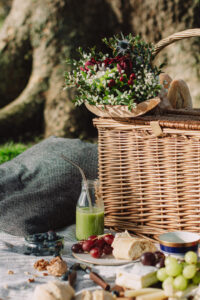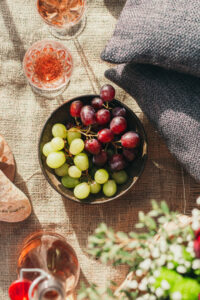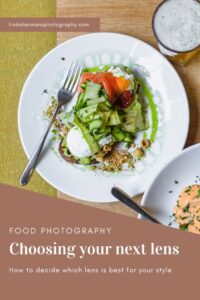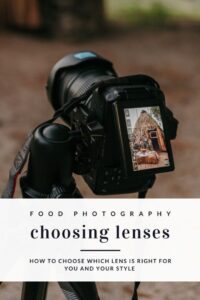Choosing lenses for food photography can be tricky, but as long as you have a good understanding of focal length and are clear on the kind of images you want to create, it gets a whole lot easier to pick one!
In this post you'll learn the basics of focal length in photography and how it impacts your images. Then we'll talk through some of the popular lenses in food photography and what they are best used for, so you can get a better idea of which lens is best for you.
Understanding lens focal length
When I first started looking at camera equipment, I was so confused by all the numbers and technical specifications. I got lost in conversations with my partner, Caleb, about lenses as I had no idea what the difference was between a 50mm lens and a 70-200mm lens, let alone what he meant when a lens only goes to "f-4"
As I researched the theory around focal length (I have an academic background, so doing research is engrained in me) I found this great description by Nikon:
The penny dropped for me with this short but effective explanation!
A longer focal length is represented by a higher number in millimetres, which means a 105mm lens has a longer focal length than a 50mm for example.
Furthermore, the 105mm lens will have a narrower angle of view than the 50mm (meaning less of the scene will be captured) and more magnified (meaning the subject will appear larger).
Below is a handy diagram that represents this:

This is a pretty nifty diagram showing how the angle of view changes with different focal lengths. Thanks to https://photographycourse.net/understanding-focal-length/ for this image.
Do I need a long focal length for food photography?
In food photography, we're able to get close to our subjects so we don't need a lens that has a super-duper long focal length. A 200mm lens is just unnecessary (unless you're trying to capture your pets running off with your food in the distance).
However, a longer focal length does have some benefits for food photography such as:
- ability to get up close to your subjects and capture beautiful macro shots
- they create more separation between the subject and background, which is another way of creating the dreamy bokeh effect
- their narrow angle of view and magnification create less distortion
For these reasons, food photographers often have a lens in the range of 80-105mm.
The image below was shot using a 100mm lens. Do you see how tight the frame is? There is a lot more going on in the picnic scene but I've only captured a single place. Also, can you see how strong the bokeh effect is - the raspberry in front of the croissant is blurry even though it's just a few centimetres away from the main subject.

The nifty fifty
One of the most popular lenses in food photography is the 50mm, particularly one that has a wide aperture (i.e. a small f-number). Learn more about camera settings, like aperture, here.
This is because it's a fairly inexpensive lens that can be used to capture beautiful food portraits as well as wider scenes if you have a tripod or C-stand to get high enough above your scene. The wide aperture will create a nice bokeh effect as well as allow plenty of light into the lens, which is great for low-light situations.
The images below were captured with my 50mm lens. I wanted use the wide aperture to draw the viewer's attention to the subjects in each image (the juice bottle in the image on the left and the bowl of grapes in the image on the right). You can see the blurred bokeh effect in both shots, where elements closer to and further away from the camera compared to the main subject are "out of focus".


Wide-angle lenses for food photography
I also shoot with a 17-40mm lens which is handy for wider flatlay scenes and interiors for restaurant shoots. I don't think this a very common lens for food photographers, but I also use it for travel and landscape shots!
A 35mm lens is a good alternative for capturing those wider table scenes (if you don't have space to move back or get far enough away from your subject when shooting with a longer focal length).
The image below was captured with my 17-40mm lens (set to around 30mm) so that I could get high enough above the picnic scene and still include all the elements such as the edge of the blanket on one side and the basket on the other. I wanted to show all these props to tell a fuller story.
My 50mm lens would have to be raised much higher above the scene in order to capture this wide of an angle.

Which lens is right for me?!
Now I want to help you figure out which lens is best for you.You have your own unique style and preferences when it comes to the subjects you shoot and how you shoot them. You and I see things differently and we want to tell our own stories in our photos - and our lenses can help us create our own, individual look and feel.If you're struggling to decide which lens to buy, or are wondering whether to get a 50mm because everyone else seems to have one - here's a suggestion:Take some time to analyse your own personal style (or review your mood board if you're still finding your style!) and identify what and how you like to shoot your subjects.
- Do you love macro shots with lots of details and texture? Maybe a lens in the range of 80-105mm would be perfect for you!
- Are you creating wider scenes and big flatlays with a deeper depth of field? Then something like a 35mm lens may well suit you better.
- Or do you take lots of single dish and drinks shots, creating beautiful food portraits? Here the 50mm would be a great fit, especially one with wide aperture capabilities to create that soft bokeh effect.
If you're thinking, "I like capturing all of the above!" then you could consider a zoom, lens like the 24-70mm with a macro option, to give you all that flexibility and variety. Or just get one of each if your budget allows
Do you see how the lens you choose should align with your shooting style and preferences?
Lenses are amazing tools and this is why I often say that the lenses you carry are more important than the camera body; they give you a lot of creative room to play and can help you express your unique voice.
I'd love to know which lens is your favourite, or which one you're thinking of getting next! Leave a comment to chat with me - I love to hear from you
Pin me for later!






0 comments